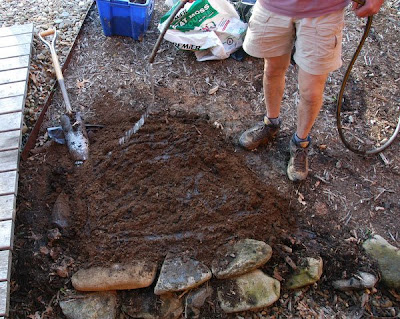Creating a bog garden
We really hadn't planned on a small bog garden, but happened on a display of carnivorous plants at a local plant festival. The keen young proprietor had many of our native pitcher plants, sundews and some Venus fly traps, along with some Australian insectivorous species. Most had been propagated by tissue culture, he said, and my gardening companion was entranced (he knows all about our native bog plants from an ecological point of view).
He set to work digging a hole.
Native bogs and savannah habitats are a wonderful aspect of the Southeastern U.S. When we lived in SE Georgia, the few remaining bogs were (and are) meccas for plant lovers. Here in South Carolina, we have the same pine savannah bogs, but also mountain cataract bogs,
supporting a range of rare species.
 Once widespread, coastal plain pitcher plant bogs have declined because of drainage, development, agriculture, etc. Wetland protection has helped some, but bogs are still rare and threatened here in the U.S., as well as elsewhere in the world.
Once widespread, coastal plain pitcher plant bogs have declined because of drainage, development, agriculture, etc. Wetland protection has helped some, but bogs are still rare and threatened here in the U.S., as well as elsewhere in the world.

 The final (but still initial) plantings
The final (but still initial) plantings
So, with encouragement from the native plant gardener (me), we acquired 2 trumpet pitcher plants (Sarracenia flava), a mountain pitcher plant (Sarracenia purpurea var. montana), and a Venus fly trap (Dionaea muscipula), native to the coastal plain in only a few sites in North and South Carolina.

I had assured him that creating a small bog wasn't hard (it basically involves some sort of liner, builder's sand, and peat, along with a source of abundant and mineral-poor water).
He was quite pleased.

Our gardening assistant provided moral support, as always.

He set to work digging a hole.
Native bogs and savannah habitats are a wonderful aspect of the Southeastern U.S. When we lived in SE Georgia, the few remaining bogs were (and are) meccas for plant lovers. Here in South Carolina, we have the same pine savannah bogs, but also mountain cataract bogs,
supporting a range of rare species.
 Once widespread, coastal plain pitcher plant bogs have declined because of drainage, development, agriculture, etc. Wetland protection has helped some, but bogs are still rare and threatened here in the U.S., as well as elsewhere in the world.
Once widespread, coastal plain pitcher plant bogs have declined because of drainage, development, agriculture, etc. Wetland protection has helped some, but bogs are still rare and threatened here in the U.S., as well as elsewhere in the world.
 The final (but still initial) plantings
The final (but still initial) plantingsSo, with encouragement from the native plant gardener (me), we acquired 2 trumpet pitcher plants (Sarracenia flava), a mountain pitcher plant (Sarracenia purpurea var. montana), and a Venus fly trap (Dionaea muscipula), native to the coastal plain in only a few sites in North and South Carolina.

I had assured him that creating a small bog wasn't hard (it basically involves some sort of liner, builder's sand, and peat, along with a source of abundant and mineral-poor water).
He was quite pleased.

Our gardening assistant provided moral support, as always.



